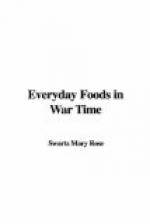Cornmeal gives as good a nutritive return per pound as cream of wheat, so that as long as the price of cornmeal is not higher than that of the wheat product it is both good economy and good patriotism to use it as far as one can. And, even if cornmeal should be dearer than wheat, one can save money by increasing the proportion of cereals in the diet so as to be able to be patriotic without increasing the food bill.
A second measure which generally makes for food economy is to emphasize the use of dried fruits and vegetables. The score of some of these foods almost speaks for itself:
Dried fruits Score value and vegetables per pound
Beans 3,350 Peas 2,960 Apples 955 Dates 1,240 Figs 1,782 Prunes 1,135 Raisins 1,550
Fresh fruits
and vegetables
Beans 472 Peas 475 Apples 156 Bananas 236 Oranges 228 Peaches 138 Pears 228
From the foregoing it is evident that, unless the cost of a pound of fresh apples is less than one-fifth that of dried ones, the dried will be cheaper; that if dates and raisins cost the same per pound they are equally economical to buy. It may be noted, too, that the return on a pound of dried fruit may be quite as good in its way as the return on a pound of a grain product, but they will be equally cheap only when they cost the same per pound in the market. Here, again, there is no incompatibility between economy and conservation of special foods. Even in the case of beans is this true, for, while certain kinds are wanted for the army and navy, there are dozens of kinds of beans; one may count it as part of one’s service to find out where these can be obtained, how they are best cooked and served. Soy beans commend themselves for their nutritive value, but how many American housewives have made them a part of their food program? How many have tried to buy them or asked their dealers to secure them?




